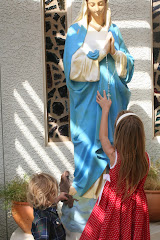If any of this sounds familiar to you and your experience with Bible reading, I have received a gem that can truly help. Well known author, Scott Hahn, has written a new book titled A Pocket Guide to the Bible. This book so cleverly written in how it breaks down all the components of the Bible. It is also super easy to read.
Hahn begins by giving his readers a good historical look of who wrote the Bible and at what belongs in the Bible. There is an interesting piece on when and why certain books were taken out of the some Christian Bibles and why the Catholic church has left them in.
I just love the chapter The Bible and the Church.
We're reminded too of how Scripture is tied to the liturgy. Many non-Catholics may not know that the liturgy in Mass is Biblical based.God revealed himself to the ages, then, through Scripture and Tradition, and both are safeguarded by the Church. The content of Scripture, the canon, was preserved through Tradition. The correct interpretation of Scripture also depended upon Tradition. St. Paul gave the Church instructions that we still follow today: "stand firm and hold to the traditions which you were taught by us, either by word of mouth or by letter" (2 Thess 2:15).
"At home, you can read the Bible-and that's wonderful. But when you go to Mass, you live the Bible".
After Hahn quickly goes through the foundation of the Bible, he gets to the part that I needed help with; understanding. He breaks down that the Bible is all kinds of literature and we just need to be aware of the various kinds. For example, there are stories like the book of Jonah with plots and and characters and morals to be learned. There are also historical events and records, poetry, wisdom literature conveying advice and letters or epistles. And although we can better see these separate kinds of literature we are reminded that:
the Bible is still one book. It tells the history of our salvation, which is certainly the most exciting story ever told.
For me the last two chapters are thought of more as Cliff's Notes- they sum it up good and quick. The Books of the Bible chapter narrows down the books with key points. I say quick because they have just a sentence or two of precise information. The last chapter Where to Find contains categories such as Stories of the Patriarchs, Stories of the Conquest and the Judges, Jesus' Life, The Birth of the Church and The Sacraments along with their Bible references. This will come in handy while homeschooling this year because I can easily find readings to coincide with what we're learning.
I know that this fast and easy to read pocket guide will aid in what's most important- my drawing closer to Jesus Christ and if it can help me, I'm confident others will benefit as well.
This review was written as part of The Catholic Company product reviewer program. Visit The Catholic Company to find more information on A Pocket Guide to the Bible.




No comments:
Post a Comment